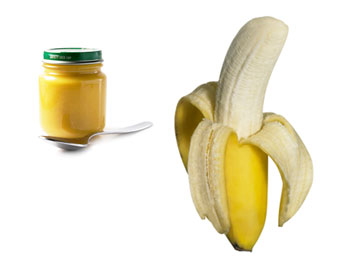
Nate is six months old when his pediatrician tells me that I can start feeding him solids. I am so excited to offer him something besides rice cereal that I run down to the store with him to buy a couple of baby-food jars. He bounces close to my body in the baby carrier.
As I peruse the “kid food” aisle, everything comes from a box or a bag or even—yogurt—from a tube.
When I get home, I crack open a jar and enjoy the pop sound of the air releasing. With Nate in the high chair and my heat-indicator spoon in hand, I give him his first bite. He sticks out his tongue over and over like a dog eating peanut butter. I burst out laughing. I try to give him another bite, and he turns away. To encourage him to eat it, I take a spoonful myself. The flavorless orange goo slides down my throat.
“Yuck!” I close the jar. “If I can’t eat this, why should you?” I ask him.
He answers with silent agreement as he always does. His smart eyes squint into a smile while the rest of his face remains serious.
The ingredients say sweet potatoes, but it smells like a sweater left in a drawer for too long. Hoping for something better, I open the banana jar. It tastes nothing like bananas.
“Great, now what?” I wonder.
I watch what other mothers feed their babies. One mom that I know loves to cook exotic sauces. She once invited a French chef to her house for a week to give her cooking lessons. She learned to take out the green middle of a garlic clove for a milder flavor. She and her husband sit down to eat a garden-fresh salad with coq au vin after their son has gone to bed on a full stomach of boiled blended spinach and potato cooked weeks ago and miles away.
I look around my kitchen. A plain old banana sits in my fruit basket. I have read that babies develop a taste for processed foods. They like banana baby food, but they swat the spoon away when offered a real banana. But is this okay? I pick up the banana. My pediatrician didn’t mention fresh bananas from my fruit basket.
I peel it. How could this be bad? I take a fork and mash it into a bowl. And then, I taste it. It is sweet and soft. Yum! I feed it to Nate and he eats it. Wow! Mashing a banana up in a bowl is about as easy as opening up a jar.
My mother-in-law invites me up to the COPIA Center in Napa to hear Marion Nestle speak about food. We sit in a small theatre. Marion Nestle tells us that food companies spend billions of dollars on advertising their products. They have shareholders who want to see increases in revenue year after year.
“You’ve got to get creative to convince people to eat 20 percent more than they did the year before,” she says. “When we walk into most grocery stores, it’s us against all that effort and money.”
I scribble down notes in my notebook.
“Real food doesn’t come in a box,” she says. “It doesn’t make food companies money.”
The next day, I run to the store, past the baby-food aisle, and buy one sweet potato. When I get home, I prick it a couple of times with a fork and then pop it in the oven. When it is soft, I take it out, cut it in half, and feed it to Nate straight from the sweet potato skin. He eats it! I beam at my success. I’m doing it! I like how there is no waste either. A sweet potato’s skin is its jar: edible, and a great bowl, too. Half a sweet potato fits perfectly in the palm of my hand. Baby-food jars suddenly seem ridiculous. Throwing a banana into the backpack is just as easy as tossing in a jar. I had to see past the doctor’s advice and the supermarket’s baby aisle, to discover the magic of eating a real banana.


Nice job Thais! Love this. Bob
Thank you, Bob. Can’t beat the support of other writers.